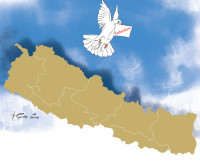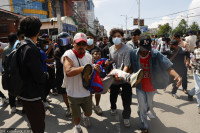Opinion
Women on the move
Gender shapes mobility and thus, constitutes an arena where female empowerment in Nepal can be discussed
Gitta Shrestha
However, if born as a female child to a Hindu society, free mobility is not guaranteed. Usually, in a Hindu society, a girl’s mobility is limited tospac-es such as farms or social and religious institutions. In many remote places, females seldom step out of their villages. Even in urban areas, a girl’s mobility is restricted to the place of birth (parental home) and the place her husband’s home. Generally, parents seek a match near their residence. And usually, whenever a woman travels, she must be accompanied by a male companion. This is not a hard and fast rule but it nevertheless poses a major obstacle.
In Nepal, women are known to reconsider scholarships and job opportunities if it involves travelling a significant distance from their home. Women must contemplate every milestone under a gender rubric, as unnecessary exposure to the outside world may impact a girl’s social standing in her community. Gender shapes mobility and external exposure, thereby constituting an arena where female empowerment in our country can be discussed.
Often, females themselves rigidly adhere to strict patriarchal norms and practices. A few years ago, while visiting Jitpur VDC, a statement by a woman caught my attention: ‘Faulty is a woman who always acts like a sheep.” Men are never victims of such criticism. Nor do they face the immense societal restraint burdened onto women. From the day a girl is born, her every action symbolises family honour. For this reason, a female must be careful of her every move. Gender-restricted mobility has become an established fact, which remains to be challenged by a majority of females.
Trekking as a woman
Trekking is a recreation that many Nepali nationals have recently started pursuing. According to the Nepal Tourism Board, domestic tourism has risen in recent years, largely attributed to greater youth participation in trekking. This is a positive impact of globalisation, which has led to distinct changes in the consumption behaviour and leisure activities of Nepalis.
Despite strong patriarchal trends in Nepal’s mountain culture, I’ve encountered a few female trekking guides. These brave women have bucked the social order to claim a stake for themselves in a lucrative but male-dominated adventure tourism industry. Nevertheless, I wonder what the precise number of females trekkers is. Nepali woman still need to make greater inroads in trekking. Women are told that they are less physically able or they possess less interest in nature. But there are quite a few female guides, porters, pilgrims and trekkers.
It is undeniable that other factors beside gender influence mobility. Often, they are health, finance and the fear of doing so for the first time. First, it is difficult to find female company to trek. Second, even if males accept females as a co-trekker, travelling with a male carries a negative stigma for females. Glaring stares welcome you all the way to and from your destination. And surprisingly, the glare is more often from women than men.
I was stared at during my entire trip from Rasuwa to Mustang, Manang, Lamjung and Doti. These looks were accompanied by statements of shock that I was the sole female among men. I responded with a gentle smile. It was difficult to determine if these were words of praise or criticism. Should I have been indignant or exasperated? Given how few Nepali female tourists visit the high hills, I should not have been shocked.
Safety fears
During my treks, I have rarely seen female Nepali co-trekkers. However, I have found many female foreigners, many of whom were travelling alone. Few were fearful of anything bad happening. Once, I met a young Israeli girl who had just finished her Bachelors degree and mandatory army training. Sometimes I think of that girl and wonder what changes we’d see in Nepal if army training was mandatory for all women. Nepali girls never dream of travelling alone. In our society, all kinds of women (from the empowered to the disempowered) are vulnerable to physical assault. This is the reason why women feel secure in numbers among men. More than anxiety about our capabilities, we fear for our physical safety.
This is true even among highly literate females who have gone overseas. Once, a friend needed a reprieve from schoolwork and suggested travel outside the Valley. She promptly panicked about travelling without male companions. I found her stuck between the risk of losing female chastity and gaining the permission of her fiancé. And this was a woman who had travelled extensively outside of Nepal. When I think of her, the statements of the women from the high mountains appear less surprising. This comparison blurs the contrast between the educated and the uneducated, the mobile and the immobile and the empowered and the disempowered.
Perhaps travelling abroad is less risky than travel within one’s own country. After all, today, freedom doesn’t guarantee any safety to women’s chastity. But the truth is that every woman is vulnerable no matter which part of the world she lives in. Women are good savers; notwithstanding, it is always men who enjoy greater mobility. Hiking, trekking, and all other outdoor leisure activities are men’s arenas. The only exception seems to be pilgrimage.
We still live in a man’s world but I accept that power and authority are in transition, although at a slow pace. There are improvements. Women are working. Female participation in outdoor activities is rising. Women in the cities are more cautious about health and recreation. Aerobics, gym, Zumba and swimming among urban women are becoming a part of daily activity. Half a decade ago, it would have been rare to see a woman jogging on the streets of Kathmandu.
Jogging as locomotion
Back in Butwal, I was always the only female jogging on the streets. Streets without women joggers are discouraging and discomforting. Stares and comments were normal. All I could do was ignore them, as if I hadn’t heard and observed anything. Change is happening. Nowadays if you start jogging early at 5am, you no longer find yourself alone. You can find a combination of female joggers—young, middle-aged and old. For a majority of the latter two, jogging is sometimes a part of the doctor’s medical prescription and for the former, the need perhaps arises out of a desire to maintain a certain appearance. Whatever the reason, the good news is that women are out on the streets. Slowly, women’s love of adventure, fitness and the wilderness is becoming apparent.
This piece certainly is not dedicated to point out the paradigms of Nepal’s tourism culture. It is, however, an attempt to represent the understudied issue of gender differences in travel. I travel because I love travelling. I try not to pass on a travel opportunity unless I face severe constraints (money, time, health). I wonder if I would have been able to enjoy the samel level of freedom in mobility if I’d been married, or if I hadn’t received the opportune exposure to travel aboard. I wonder if my earnings alone would have bought me mobility free of social, cultural and gender dogmas. I wonder if I would have been similarly independent in deciding my mobility if I wasn’t living away from my family.
It is true that there are several entwined determinants, yet it is women who ought to strive to break free. Unless women put in efforts, they will be literally caged inside and around her man’s, family’s and society’s labyrinth. I ponder over the relative weight of social and cultural precincts against the recently emerging economic prosperity of females; the transformation of power; and the degree of freedom in decision making enjoyed by females in this country. Until now, cultural norms and stigmas weigh more than improvements in woman’s social and economic standings. There are long-term challenges and they won’t be overcome until women themselves try to defy them. Hopefully, in the coming years, women will be encouraged to venture out into the wilderness and into the world.
Shrestha is a researcher at Nepal Centre for Contemporary Research




 13.12°C Kathmandu
13.12°C Kathmandu
.jpg&w=200&height=120)







%20(1).jpg&w=300&height=200)

